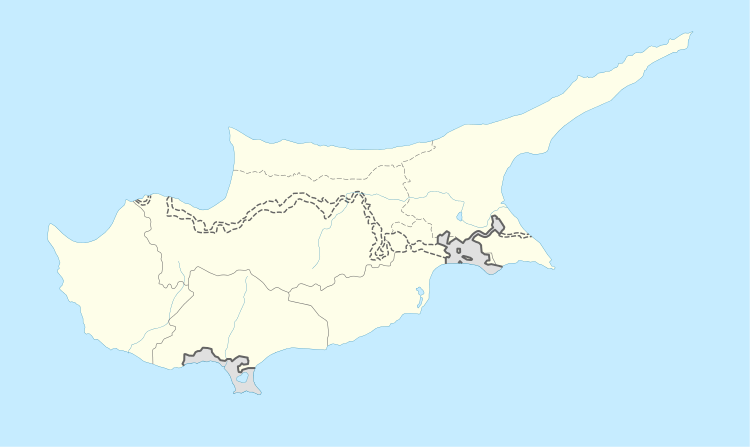Ayios Nikolaos Station
| Ayios Nikolaos Station | |
|---|---|
| Άγιος Νικόλαος | |
| Part of NSA-Composite Signals Organisation | |
| Dhekelia Cantonment, Cyprus | |
 | |
 Ayios Nikolaos Station | |
| Coordinates | 35°05′35″N 33°53′12″E / 35.09306°N 33.88667°ECoordinates: 35°05′35″N 33°53′12″E / 35.09306°N 33.88667°E |
| Type | Satellite ground station and eavesdropping centre |
| Site information | |
| Owner | Government of the United Kingdom |
| Condition | Active |
| Site history | |
| Built | c.1946 |
| In use | c.1946–present |
Ayios Nikolaos Station (also spelled Agios Nikolaos; Greek: Άγιος Νικόλαος, lit. "Saint Nicholas") is a British military station and part of in the British Sovereign Base Area of Dhekelia in Cyprus. It is a former village (Ayios Nikolaos, SBA) connected by a road to the main area of the Dhekelia Garrison. The Joint Service Signal Unit (Cyprus) (JSSU(Cyp)), formerly 9th Signal Regiment and the Royal Air Force's 33 Signals Unit, is based at Ayios Nikolaos. This unit is a British Armed Forces run electronic intelligence gathering station.[1]
History
The station was established at Ayios Nikolaos shortly after the Second World War.[2] In 1946 2 Wireless Company and 2 Special Wireless Group merged to become 2 Wireless Regiment RSigs. In 1959 2 Wireless Regiment became 9 Signal Regiment.[3] JSSU (Cyp) was formed on 1 April 1999 as a result of the amalgamation of the Joint Service Signal Unit (Ayios Nikolaos) and elements of 33 Signals Unit RAF.[4] It is a three-squadron organisation, commanded by a Royal Signals Lieutenant Colonel, with a number of Royal Air Force and civilian contractors attached. Ayios Nikolaos or Agios Nikolaos is a very common place name in Greece and Cyprus; it is Greek for "Saint Nicholas".[5]
For satellite interception, the Ayios Nikolaos station has a number of dish antennas of various sizes. Somewhere between 2008 and 2011, also a torus antenna was installed, which is able to receive the signals of up to 35 satellites simultaneously.[6]
Declassified documents show that the station was run for the Government Communications Headquarters (GCHQ), and documents released by Edward Snowden suggest that in recent years half the cost of running the station is funded by the U.S. National Security Agency.[7] It became the largest GCHQ site outside the UK.[2]
See also
References
- ↑ Jeffrey T. Richelson & Desmond Ball, The Ties the Bind: Intelligence Cooperation between the UKUSA Countries, Unwin Hyman, Boston/London and others, 1990, p.194 note 145.
- 1 2 Georgiou, Giorgos. "British Bases in Cyprus and Signals Intelligence" (PDF). Retrieved 22 October 2017.
- ↑ Lord, Cliff; Watson, Graham (2012). The Royal Corps of Signals: Unit Histories of the Corps (1920-2001) and Its Antecedents. Helion & Company Limited. pp. 41–42. ISBN 9781874622925.
- ↑ Ayios Nikolaos Station archived on 5 August 2009 from the original Archived November 9, 2009, at the Wayback Machine.
- ↑ "Location of St. Nicholas Church". Agios Nikolaos. Retrieved 18 October 2017.
- ↑ Electrospaces.net: Torus: the antenna to significantly increase satellite interception, April 8, 2015
- ↑ "GCHQ worked hard to maintain presence on Cyprus after independence". Gloucestershire Echo. 1 December 2013. Archived from the original on 14 April 2015.